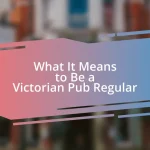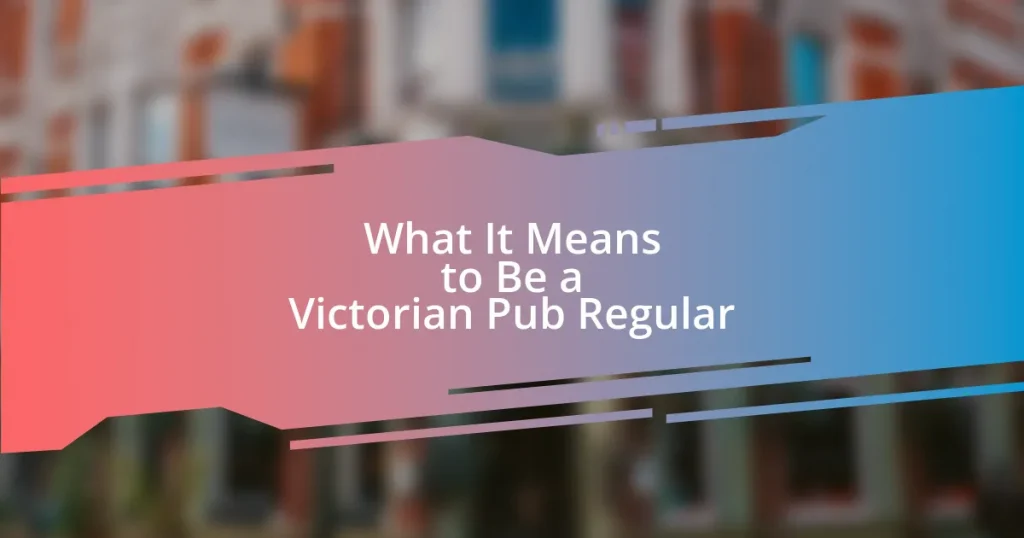Key takeaways:
- The Victorian era (1837-1901) transformed pubs into vital social hubs, fostering community connections and public discourse.
- Pubs showcased architectural diversity and hosted various traditions, like games and toasting, that reinforced community spirit.
- Key figures in pub culture, such as publicans and local brewers, played significant roles in creating atmospheres of familiarity and unity.
- The interiors of Victorian pubs served as reflections of local culture and history, enhancing social interactions and connections among patrons.

Overview of Victorian Pub History
The Victorian era, spanning from 1837 to 1901, marked a vibrant chapter in British pub culture. Pubs during this time evolved into essential social hubs, where people gathered not just to drink, but to connect and share stories. Isn’t it fascinating how these establishments served as the heartbeat of the community?
I remember exploring a beautifully preserved Victorian pub during my travels, and the atmosphere was rich with history. The intricate woodwork and stained glass whispered tales of lively discussions and laughter that once filled its space. Can you imagine the kinds of conversations that happened over a pint in those days? The warmth of camaraderie must have been palpable, creating a sense of belonging that draws people in even today.
Another interesting aspect is the sheer variety of establishments that emerged, from grand taverns to smaller local inns. Each place had its unique character, reflecting the area’s culture and history. I often think about how these pubs were microcosms of society, showcasing a blend of different classes and backgrounds. How much can we learn from these social dynamics when we step into a pub today? The stories woven into their walls still resonate, reminding us of a time when pubs were more than just places to grab a drink.

Importance of Pubs in Society
Pubs have long served as vital social spaces in communities, offering more than just drinks. They are where people forge connections, celebrate milestones, and sometimes even share their burdens. I recall one chilly evening spent in an old pub, huddled with strangers around a flickering fireplace, our laughter merging with the crackling wood. That night, I truly felt the power of shared experiences, highlighting how pubs can foster a sense of unity among diverse groups.
Moreover, in the Victorian era, pubs became critical venues for public discourse. They often hosted discussions about politics, art, and local events, enabling patrons to engage with the world around them. It made me think about my own experiences at a pub quiz night, where debates sparked spirited conversations. Those moments serve as a reminder of how important these institutions were in shaping opinions and fostering a collective voice.
Finally, pubs offered a counterbalance to the rigid social structures of Victorian society. They provided a space where individuals from varying backgrounds could interact freely, breaking down barriers that may have existed in other settings. I often reflect on how I’ve met people from all walks of life in pubs. Each encounter has widened my perspective, showing how these venues can act as social equalizers. These experiences underline the importance of pubs as not just places to drink, but as sites of community and connection.
| Function of Pubs | Impact on Society |
|---|---|
| Socializing | Fosters community and belonging |
| Public Discourse | Encourages civic engagement and discussion |
| Inclusivity | Bridges social divides |

Architectural Styles of Victorian Pubs
Victorian pubs are a delightful reflection of architectural diversity, encompassing various styles that convey their distinct character and purpose. The brickwork, ornate facades, and intricate detailing often evoke a sense of nostalgia for the past while also showcasing the craftsmanship of that era. I remember visiting a pub adorned with beautiful terracotta tiles, which not only added charm but also seemed to tell stories of countless patrons who had walked through its doors.
The architectural features of Victorian pubs typically include:
- Gothic Revival: Pointed arches and elaborate decorative elements that create a dramatic atmosphere.
- Italianate: Low-pitched roofs and large windows that give a more relaxed but refined feeling.
- Queen Anne Style: A mix of textures and asymmetrical shapes, this style feels approachable and warm, inviting you in for a pint.
- Edwardian Influence: Often simpler and more functional designs that reflect the changing social landscape of the time.
Each style contributes to a unique ambiance that resonates with different aspects of community life. I often find myself drawn to nooks within these pubs, cozy corners that seem to whisper echoes of laughter and debate, inviting me to be part of the ongoing story.

Popular Victorian Pub Traditions
The tradition of pub games in the Victorian era is one that resonates deeply with me. I can still picture an old pub where the sound of laughter echoed alongside the clatter of dice and the cheers during a boisterous game of skittles. These games were more than just a pastime; they strengthened camaraderie among patrons, igniting friendly competition that often led to unforgettable nights. Can you imagine the stories exchanged over a pint while engaging in a spirited game?
Another fascinating custom was the ritual of toasting. In the Victorian period, toast was not just about raising a glass; it was an art form. People would compose clever verses or heartfelt sentiments before clinking glasses, binding communities in shared joy and solidarity. I remember a toast I heard, given at a friend’s gathering; it transformed the mood, creating a moment of genuine connection among everyone present. Isn’t it incredible how a few well-chosen words can linger in our memories?
Lastly, beer festivals were popular gatherings celebrating local brews, and I can only imagine the vibrant atmosphere they created. These events allowed breweries to showcase their finest ales, fostering a sense of pride within communities. I once attended a local beer fair, and the energy was infectious—it felt like a collective heritage was being honored and shared. The tastes, the laughter, the sense of belonging—it all illustrated how Victorian traditions in pubs exemplified community spirit in ways that still resonate today.

Influential Figures in Pub Culture
As I delve into the world of Victorian pub culture, it’s impossible to overlook figures like the publican, who held the entire atmosphere together. I recall walking into a small, beloved pub where the publican knew not just names but also the stories behind every patron sitting at the bar. This personal connection transformed the simple act of ordering a drink into a warm exchange steeped in familiarity. Isn’t it remarkable how one person can create a sense of belonging?
Another influential figure is the local brewer, whose craft not only shaped the pub’s offerings but also defined the community’s social fabric. I once visited a historic brewery that had been family-owned for generations, where the brewer enthusiastically shared the methods passed down through the ages. It struck me how their dedication to quality created not only celebrated ales but also bonds among neighbors who gathered to share a pint. Have you ever felt that sense of unity over a locally brewed beer?
Finally, we can’t forget the authors and poets who found inspiration within pub walls. I remember reading about Charles Dickens frequently visiting pubs, where his characters seemed to come alive amidst the lively discussions and laughter. Their work immortalized these spaces as cultural hubs, fostering creativity and camaraderie. It’s intriguing to think how the pages of literature would look different without the influence of vibrant pub conversations. How many unforgettable tales have been told over a pint, shaping both words and imaginations?

Exploring Victorian Pub Interiors
Exploring Victorian pub interiors is like stepping into a living museum of social life. The rich wood paneling and intricate bar fittings are not just aesthetically pleasing; they tell stories of joyous gatherings and late-night debates. I remember being captivated by the ornate glasswork in one pub; it felt as if I was gazing through windows to yesteryear, where patrons would share tales over a pint, creating an atmosphere of warmth that drew people in.
The layout of Victorian pubs also intrigues me, emphasizing sociability in unique ways. Smaller, intimate corners nestled within the main room invite quiet conversations, while sprawling communal tables encourage lively discussions among strangers. I once sat at such a table and found myself engaged in a spirited chat with a group of locals, igniting an unexpected sense of community. Hasn’t a simple setup like this transformed the way we connect with one another?
Additionally, the décor often reflects local culture and history, with memorabilia and artwork that mirror the spirit of the neighborhood. I recall an old pub that featured photographs of its founders and past patrons on the walls, creating a tangible link to the community’s heritage. Seeing those images sparked a curiosity in me about their stories. Isn’t it remarkable how a well-curated interior can evoke such emotional ties and encourage us to forge deeper connections in the present?













